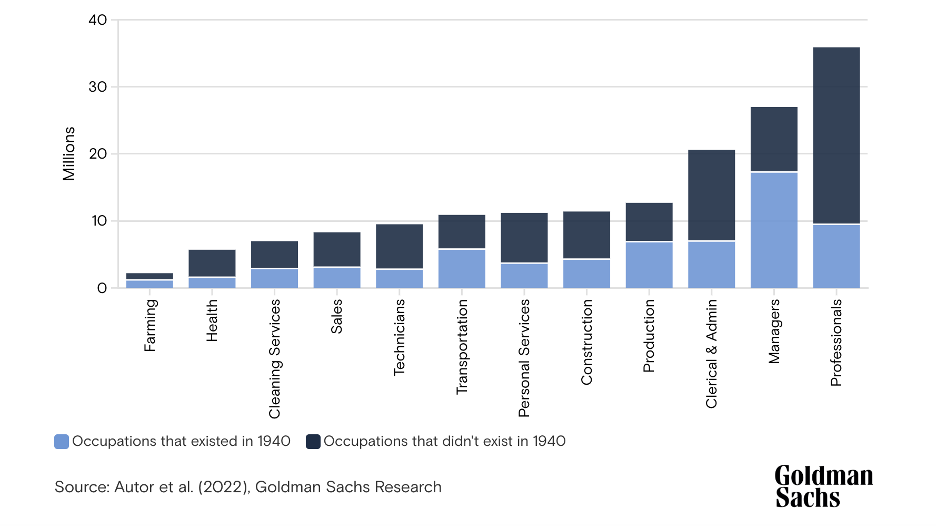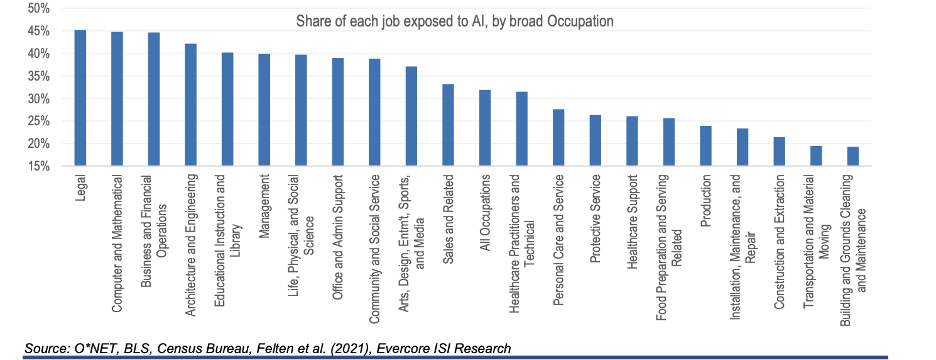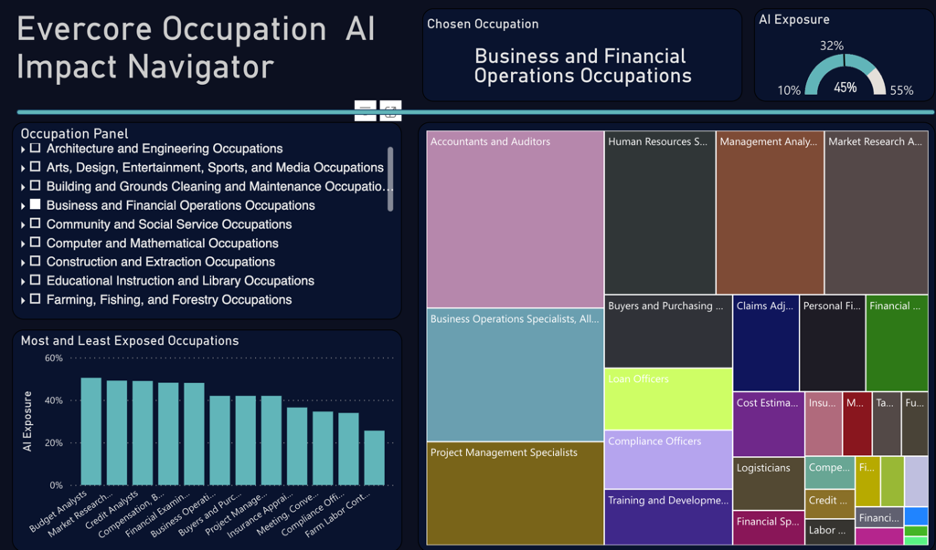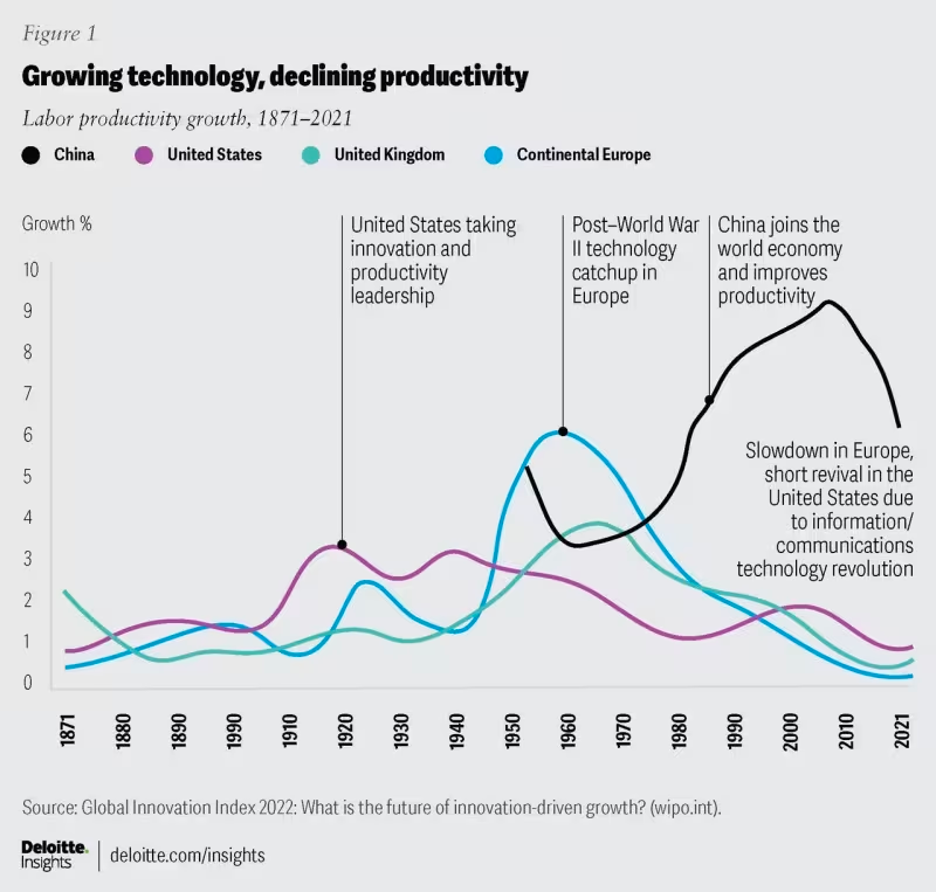What you can do to remain relevant


Introduction
I once had a business school professor who said, “Technological change is inevitable; these changes can chew up a generation of workers, but productivity improves, and for the most part, people’s lives also improve as a result of these changes.” For some oddity, that comment stuck with me throughout the years and seems more relevant today than ever.
As artificial intelligence (AI) continues to permeate society and the business world, the question of whether AI will take your job is at the top of many professionals’ minds–myself included. The combined powers of traditional AI (aka predictive AI) and generative AI are poised to redefine how work is conducted. Generative AI is not our first technological revolution by any means. As I mentioned in my article Digital Marketing in the Age of AI Disruption (Part 1), we’ve seen mechanization, industrialization, and digitization, to name a few.
Figure 1: Past Technological Revolutions


To briefly recap,
- The Second Industrial Revolution (Electricity + Internal Combustion = Mass Production): From the mid-19th to the early 20th century, the Second Industrial Revolution marked a profound shift in economies, moving them from agrarian bases to industrial ones. With advancements in technology such as electricity, internal combustion engines, and significant developments in chemical, petroleum, and steel industries, this era transformed the nature of manufacturing. While it optimized production processes and increased efficiency, it wasn’t so much about automating tasks, but rather, it was about revolutionizing them–leading to mass production and the rise of urban factory-based economies.
- Digitization (Electronics + IT = Automated Production): Beginning in the 1950s, the digital revolution marked a significant technological and societal shift as computers, databases, and, later, the internet and mobile technology became increasingly prevalent. Once again, digitization fundamentally transformed our work, enabling automated production processes and creating an information-based economy. It revolutionized communication and led to the creation of new job sectors and an interconnected global economy. Remember Dell’s mass customization strategy from the 1990s?
- The Age of AI (Data + Analytics + Automation = Automated Decisions and Content): Building upon digitization, steady advancements have been made in computing, storage, and machine learning (ML) technologies, ushering in the Age of AI. In 2017, researchers from Google published their seminal paper “Attention is All You Need,” which laid the foundation for transformer architecture, which powers generative AI.[1] This is the period we are currently in, and it’s undoubtedly a transformative one. Combined with traditional AI, systems can now forecast, predict, and optimize, as well as generate text, images, pictures, and videos. With more precision than ever before, AI systems can now contextually understand propensities and automate content generation in real-time. Essentially, tailoring every interaction to your whims and fancies–for better or worse.
This article will examine why the AI revolution differs from the past, examine current research and thinking on how generative AI will impact the future of jobs, and offer practical advice on staying relevant.
AI: the Creator or Destroyer of Jobs?
Research from Goldman Sachs indicates that AI could partially automate two-thirds of all jobs.[2] In fact, this same research suggests that technological revolutions often create more jobs than they destroy. Case in point, Figure 1.2 compares the number of jobs that existed in 1940 to those that didn’t.
Figure 1.2: AI Creates More Jobs than It Destroys


Based on work from MIT economist David Autor, the research suggests that 85% of employment growth for the past eight decades is due to technology.
“60% of today’s workers are employed in occupations that didn’t exist in 1940. This implies that more than 85% of employment growth over the last 80 years is explained by the technology-driven creation of new positions.”[3]
The same Goldman Sachs study states, “shifts in workflows triggered by these advances could expose the equivalent of 300 million full-time jobs to automation” and “two-thirds of occupations could be partially automated by AI.”[4]
So, this makes sense–we didn’t have iPhone technicians, video game developers, digital marketing experts, and prompt engineers in the 1940s. But it still begs the question, how will it impact my job? Will my generation be “chewed up” by the The Age of AI?
AI’s Impact on Your Job
Investment Bank Evercore compiled some fascinating research on AI’s impact on specific job functions. It turns out that the U.S. Department of Labor maintains a database of 800+ occupations in its O*NET database.[5] For each of these occupations, they have cataloged forty-one work activities and fifty-two AI-exposed abilities. Here is the data for the marketing manager, which I know well.
Top Five Work Activities for Marketing Manager (number in parentheses represents an importance factor):
- Communicating with supervisors, peers, or subordinates (94): providing information to supervisors, co-workers, and subordinates by telephone, in written form, e-mail, or in person.
- Establishing and maintaining interpersonal relationships (92): developing constructive and cooperative working relationships with others, and maintaining them over time.
- Working with computers (85): using computers and computer systems (including hardware and software) to program, write software, set up functions, enter data, or process information.
- Making decisions and solving problems (84): analyzing information and evaluating results to choose the best solution and solve problems.
- Organizing, planning, and prioritizing work (84): developing specific goals and plans to prioritize, organize, and accomplish your work.
Top Five Abilities for Marketing Manager (number in parenthesis is the importance factor):
- Oral comprehension (75): the ability to listen to and understand information and ideas presented through spoken words and sentences
- Written comprehension (75): the ability to read and understand information and ideas presented in writing.
- Oral expression (75): the ability to communicate ideas in speaking so others will understand.
- Written expression (72): the ability to communicate information and ideas in writing so others will understand.
- Deductive reasoning (72): the ability to apply general rules to specific problems to product answers that make sense.
Using the AI Occupational Exposure (AIOE) methodology described in Occupational, industry, and geographic exposure to artificial intelligence: A novel dataset and its potential uses, Evercore crunched the numbers and found that the average job exposure was 32%, with some jobs only having 10% exposure while others had 50%+ exposure.[6],[7]
Figure 1.1: Share of Each Job Exposed to AI, by Job


Additionally, Evercore also created some nice PowerBI dashboards for each set of occupations, and I encourage you to look up your specific occupation. How much will AI impact your job?
Figure 1.2: AI Exposure for Business and Financial Operations Occupations


Now that we know how much AI may affect your job, how do companies think about this?
The Productivity Illusion
Based on research conducted at Harvard, MIT’s report How generative AI can boost highly skilled workers’ productivity stated that generative AI can boost worker productivity by 40%.[8] Fantastic, with the 40% increase in worker productivity, will the four-day workweek become a reality? Doubtful.
Companies are obsessed with productivity. On the surface, this makes sense since the more productive they are, the more profit they can drive. The calculation is pretty straightforward:
Productivity = Total Output / Input.
For machines in a factory, this makes perfect sense. However, does it make sense for people? Well, venture capitalists seem to think so. For example, in Silicon Valley, the labor productivity per employee was $290,400 per employee (~$140 per hour) and grew by 22% between 2016 and 2021.[9]
However, if we take a step back, overall productivity has steadily declined since the 1950s.[10]
Figure 1.3: Decreasing Productivity


That tidbit was surprising to me. With all of the technological advancements, productivity has actually decreased. Maybe we see this in our jobs daily–with Slack, Teams, eMail Asana, Zoom, Google Drive, Gong, and countless ways to interact and share content–people spend an inordinate amount of time simply trying to keep up with all the requests and find the channel or file where someone had that critical document or feedback that is needed for your project. Personally, I think my productivity has decreased in this respect. I can’t seem to find anything easily.
Nowadays, businesses track your every keystroke, phone call, meeting, online status, hours worked, and much more. A study by Slack revealed that 27% of executives rely on activity and visibility metrics to measure productivity.[11]With the heightened surveillance, employees are under pressure to always be on and respond to things instantaneously. This leads to increased performative work–essentially, doing things to make you look busy. Measuring productivity in tech companies is impossible anyhow. As companies increasingly rely on third parties (agencies, contractors, etc.), they cannot gain an accurate view of productivity across the entire ecosystem.
So, I will go out on a limb and say that perhaps productivity isn’t the best measure for an individual human. As of now, I don’t think they can measure how much time we spend thinking and finding creative ways to move the business forward. One big idea can change the course of a business, solution, or product launch–traditional methods can’t measure this. As both traditional and generative AI automate more tasks–our creativity and problem-solving skills will be the differentiator for companies.
In Deloitte’s article Outcomes over outputs: Why productivity is no longer the metric that matters most, the authors argue that organizations should shift their measurement system from productivity to business outcomes–which capture the “value, quality, or desired result of work.”[12] They point out that knowledge workers wear many hats in today’s world. In other words, they don’t just do one job or task (like a machine); knowledge workers perform many activities spanning multiple job functions.
If we want employees to focus on delivering value for companies, they should focus on desired business outcomes. Remember our productivity equation? Output for a company is not worker output, but rather, it’s customers who buy our products and services. Focusing on outcomes allows humans to do what they do best–use creativity and ingenuity to accomplish their goals. We want our employees to focus on doing the right things to move the business forward, not performative work.
Deloitte’s article also suggests that “human outcomes should be part of the equation: the goals and objectives that help an organization’s people thrive physically, emotionally, financially, and professionally.”[13] There is some merit to this argument. When Hitachi experimented with this, they found that when “psychological capital of workers rose by 33% and profits climbed by 10%,…..sales per hour increased by 34% at call centres and sales at stores went up by 15%. Testing has been carried out with 83 organisations and 4,300 people.”[14]
Unfortunately, this is not at the top of many CEO’s agendas.
Why is this Different?
As we have learned from industrialization and digitization, these past revolutions transformed the workforce, phasing out roles like blacksmiths, weavers, and typists while creating new ones such as electrical engineers and software developers. Today, in The Age of AI, the bulk of our workforce consists of knowledge workers, a segment that AI is poised to impact disproportionately.
Like the Luddites, who feared mechanized looms and knitting frames would replace skilled labor, AI’s influence on knowledge workers is profound yet distinct. Generative AI is the great skill equalizer and will create a convergence in skill sets–most will regress to the mean. Fundamentally, lower-skilled employees will have their skills improved to an average skill level. It’s estimated that 40% of workers will need to upskill or reskill to adapt to The Age of AI.[15]
As the development of AI agents progresses, this will further emphasize the need for reskilling. Unlike previous shifts, AI’s integration into knowledge work doesn’t just create new roles; it fundamentally alters the nature of existing ones. If 2023 is any indicator, we will see continued layoffs in the tech sector in 2024.[16]
With executives eyeing the generative AI prize of enhanced productivity, they may use this as an excuse to let people go and defer hiring. However, I caution leaders that this approach will likely fail, putting them at a long-term competitive disadvantage. Generative AI should necessitate a more nuanced response from leaders and practitioners alike.
What Can You Do to Stay Relevant?
Given the macroeconomic trends and productivity illusion, what can you do to remain relevant?
For Individuals
Upskill and Reskill
For individual practitioners, adaptability in the AI era hinges on a personal commitment to continuous learning and skill development. Actively seek opportunities for learning new skills, particularly in areas where AI and automation are evolving. This could involve engaging in online courses, attending workshops, or participating in industry conferences. I’d recommend focusing on skills AI cannot easily replicate, such as creative problem-solving, strategic thinking, and collaboration.
Network
Embrace AI’s possibilities by being open to new job roles and industries. Networking and collaborating with peers from diverse fields can offer valuable insights and opportunities for interdisciplinary growth. Don’t hesitate to explore roles beyond your comfort zone, as AI will create new niches and specializations within your industry. Take control of your reskilling journey to not only stay relevant in a rapidly evolving job market but also position yourself as a valuable asset in the workforce of tomorrow.
Get Hands-On with the Tech
To truly grasp something, there’s no better approach than getting hands-on. Engage in courses, dive into experiments, and establish a strong foundation in artificial intelligence (AI) and its associated technologies. Personally, I’ve taken several over the past couple of months. This will unlock work prospects and help your career.
For Businesses:
Create a Learning Culture and Invest in Training
As AI alters the nature of jobs, the half-life of skills is shrinking, necessitating a proactive approach to lifelong learning. Business leaders should prioritize developing learning programs that are agile, adaptable, and aligned with emerging technologies. Companies like Infosys and Vodafone have successfully implemented large-scale reskilling initiatives, underscoring the importance of staying ahead of the curve in skill development.[17]
Double Down On Talent
Strategically focus on attracting individuals with specialized skills in AI, data analysis, automation, ethics, and digital technologies. These areas are becoming increasingly crucial for businesses looking to stay competitive and innovative. By prioritizing talent recruitment in these fields, companies can ensure they are well-equipped to harness the power of AI and data-driven insights, enabling them to adapt to changing market dynamics and capitalize on new technological opportunities.
Invest in AI Tech
Become AI-driven, not data-driven. It’s crucial to begin with a clear vision of the end goal and then work backward. Don’t implement AI just for the sake of it. You need to create a Tiger Team to identify the key opportunities within your business. Only then can you move forward effectively.
Summary
The question of whether AI will take our jobs is nuanced. It’s undeniable that AI will lead to significant changes in the job market, but this doesn’t necessarily spell obsolescence for human workers–it never has and never will. Instead, it heralds a period of evolution and adaptation. As business leaders and practitioners, the key is not to resist this inevitable AI revolution but to prepare for it proactively. By investing in upskilling and reskilling, embracing the changes brought about by AI, and strategically aligning workforce capabilities with future business needs, we can turn potential disruption into an opportunity for growth and innovation. The future of work with AI isn’t just about technological advancement; it’s equally about the human capacity to adapt, learn, and thrive alongside these new tools.
Will AI take my job? Perhaps, but I’m not worried. There’s no doubt that my job will evolve. You can’t stop the AI revolution, but you can prepare yourself by investing in your skills and trying the technology for yourself. I remain optimistic–who knows, maybe we’ll get that four-day workweek.
If you enjoyed this article, please like it, highlight interesting sections, and share comments. Consider following me onMedium and LinkedIn.
If you’re interested in this topic, consider TinyTechGuides’ latest report, The CIO’s Guide to Adopting Generative AI: Five Keys to Success or Artificial Intelligence: An Executive Guide to Make AI Work for Your Business.
[1] Vaswani, Ashish, Google Brain, Noam Shazeer, Niki Parmar, Jakob Uszkoreit, Llion Jones, Aidan Gomez, Łukasz Kaiser, and Illia Polosukhin. 2017. “Attention Is All You Need.” https://proceedings.neurips.cc/paper_files/paper/2017/file/3f5ee243547dee91fbd053c1c4a845aa-Paper.pdf.
[2] Goldman Sachs. 2023. “Generative AI Could Raise Global GDP by 7%.” Goldman Sachs. April 5, 2023. https://www.goldmansachs.com/intelligence/pages/generative-ai-could-raise-global-gdp-by-7-percent.html.
[3] Goldman Sachs. 2023. “Generative AI Could Raise Global GDP by 7%.” Goldman Sachs. April 5, 2023. https://www.goldmansachs.com/intelligence/pages/generative-ai-could-raise-global-gdp-by-7-percent.html.
[4] Goldman Sachs. 2023. “Generative AI Could Raise Global GDP by 7%.” Goldman Sachs. April 5, 2023. https://www.goldmansachs.com/intelligence/pages/generative-ai-could-raise-global-gdp-by-7-percent.html.
[5] National Center for O*NET Development. 2023. “O*NET OnLine.” Onetonline.org. 2023. https://www.onetonline.org/.
[6] Felten, Edward, Manav Raj, and Robert Seamans. 2021. “Occupational, Industry, and Geographic Exposure to Artificial Intelligence: A Novel Dataset and Its Potential Uses.” Strategic Management Journal 42 (12). https://doi.org/10.1002/smj.3286.
[7] Emanuel, Julian, Michael Chu, and Barak Hurvitz. 2023. “Equity and Derivatives Strategy Macro Note Generative AI Productivity’s Potential, from Macro to Micro.” https://www.evercore.com/what-we-do-equities-research-genai/.
[8] Somers, Meredith . 2023. “How Generative AI Can Boost Highly Skilled Workers’ Productivity | MIT Sloan.” Mitsloan.mit.edu. October 17, 2023. https://mitsloan.mit.edu/ideas-made-to-matter/how-generative-ai-can-boost-highly-skilled-workers-productivity.
[9] “Silicon Valley Index People Economy Society Place Governance INSTITUTE for REGIONAL STUDIES JOINT VENTURE SILICON VALLEY.” 2022. https://jointventure.org/images/stories/pdf/index2022.pdf.
[10] Hatfield, Steve, Sue Cantrell, and Corrie Commisso. 2023. “Why Productivity Is No Longer the Metric That Matters Most.” Deloitte Insights. July 19, 2023. https://www2.deloitte.com/uk/en/insights/topics/talent/measuring-productivity.html.
[11] “The State of Work in 2023.” 2023. Slack. June 23, 2023. https://slack.com/blog/news/state-of-work-2023.
[12] Hatfield, Steve, Sue Cantrell, and Corrie Commisso. 2023. “Why Productivity Is No Longer the Metric That Matters Most.” Deloitte Insights. July 19, 2023. https://www2.deloitte.com/uk/en/insights/topics/talent/measuring-productivity.html.
[13] Hatfield, Steve, Sue Cantrell, and Corrie Commisso. 2023. “Why Productivity Is No Longer the Metric That Matters Most.” Deloitte Insights. July 19, 2023. https://www2.deloitte.com/uk/en/insights/topics/talent/measuring-productivity.html.
[14] Lessa-Nguan, Suchit. 2020. “Hitachi’s AI for Employee Joy.” Bangkok Post, February 7, 2020. https://www.bangkokpost.com/business/1852194/hitachis-ai-for-employee-joy.
[15] “The Augmented Workforce for an Automated, AI-Driven World.” n.d. IBM. https://www.ibm.com/thought-leadership/institute-business-value/en-us/report/augmented-workforce.
[16] Stringer, Alyssa, and Cody Corrall. 2023. “A Comprehensive List of 2023 Tech Layoffs.” TechCrunch. December 21, 2023. https://techcrunch.com/2023/12/21/tech-layoffs-2023-list/.
[17] Tamayo, Jorge, Leila Doumi, Sagar Goel, Orsolya Kovács-Ondrejkovic, and Raffaella Sadun. 2023. “Reskilling in the Age of AI.” Harvard Business Review. September 1, 2023. https://hbr.org/2023/09/reskilling-in-the-age-of-ai.



